5p/Ps Steel Billets Q235,Q255,Q275,Q345,3SP,5SP,20MnSi
- Loading Port:
- China main port
- Payment Terms:
- TT OR LC
- Min Order Qty:
- 20 m.t.
- Supply Capability:
- 200000 m.t./month
OKorder Service Pledge
OKorder Financial Service
You Might Also Like
5p/Ps Steel Billets Q235,Q255,Q275,Q345,3SP,5SP,20MnSi
Specification
Steel billet(ingot) by cogging or breakdown of semi-finished products, is the raw material of all kinds of steel mill. Billet section of square, round, flat, rectangular and abnormity of several kinds of, mainly related to the shape of rolled products.
CNBM Q235,Q275,Q345,3SP,5SP,20MnSi Billets Steel
Hot Rolled Steel Billets/ Mild Steel Bar/ Billet Steel
Specification (see below)
Standard: GB/JIS/ASTM
Size: 50*50mm-180*180mm
Length: 3-12mtrs or Customised
Steel material: Q235,Q255,Q275,Q345,3SP,5SP,20MnSi
Technique: Hot rolled
FOB Unit Ton Price $250-350 and Usually I will quote you CFR price.
MOQ: Usually 1000-10000MT/size
Shipment:By Container,Bulk Vessel
Packaging Details: bundles with steel strips or as customers's requirements
Delivery time: Usually within 30 days after the deposit/LC
Inspection:Third party inspection before loading.
Technical data
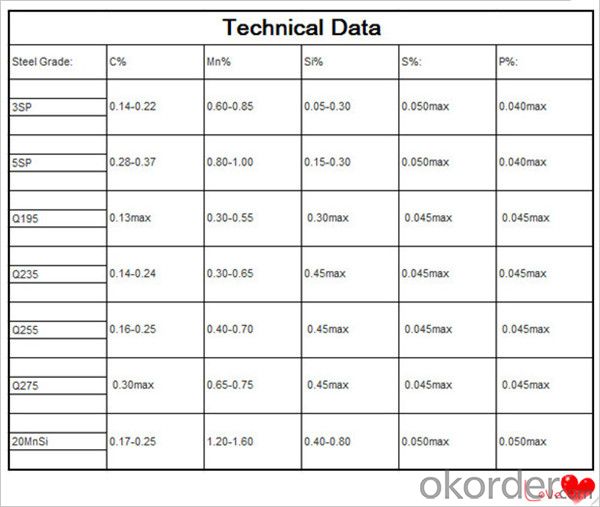
Feature Steel Billet
Rectangular billet continuous casting billet and mainly general carbon steel, low carbon low silicon cold-rolled material, high quality carbon structural steel, high strength low alloy steel, special steel, etc.
The billet is mainly divided into two kinds from the shape:
Slab: cross section width and height of the ratio of the larger, mainly used for rolling plate.
Billet: equal cross section width and height, or a huge difference, mainly used for rolling steel, wire rod. ,
Steel billets have distinct characteristics as compared with already furnished steel bars and products. Billets have a specific grain structure, which enables the metal to be processed more intricately. Steel billets are also known for their malleability and ductility, especially when exposed to varying temperatures during shaping and molding.
Packaging & Shipping
1. Packaging:
1) Small size: in bundles
2)Big size: in bulk
3)in plastic packing or as per customer requirement
2. Delivery time:
1) Normal size: within 7days send from warehouse directly
2) Special size: with 25-30days customer made for you
3. Trade terms:FOB/CFR/CIF
4. Shippment:
1) length:≤5.8m loaded in 20FT Container with 25-27tons
2) length:≤11.8m loaded in 40FT Container with 25-27tons
3) lengnth:≥12m shipped by bulk vessel, FILO terms
Steel Billet Images
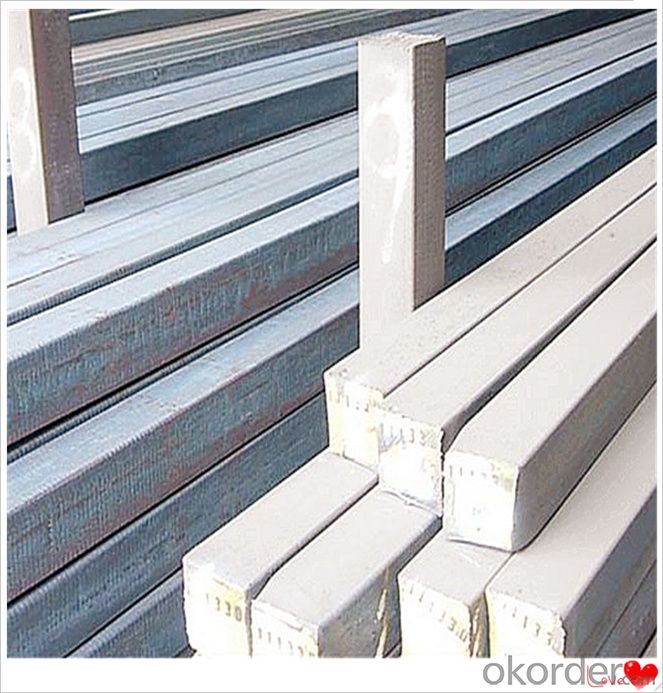
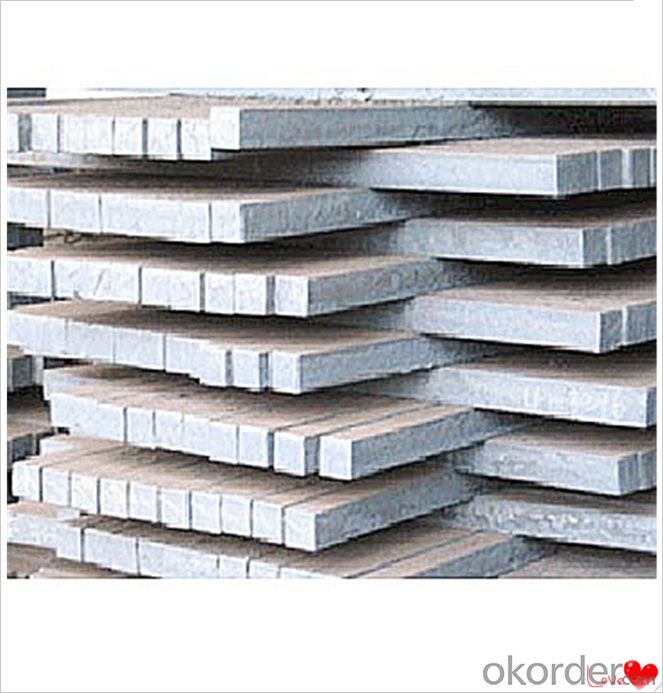
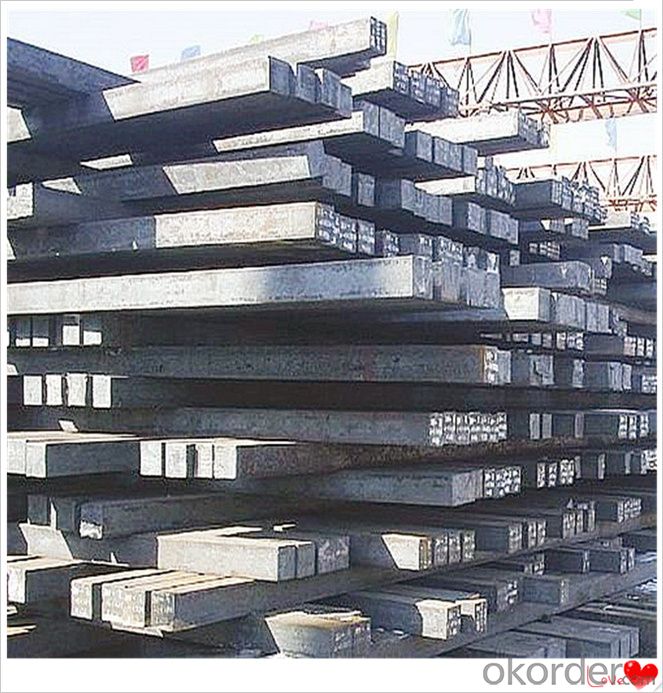

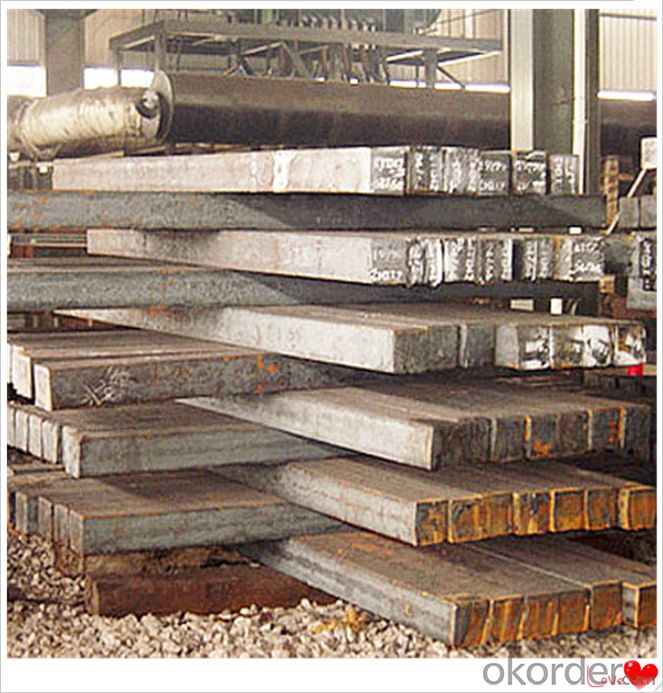
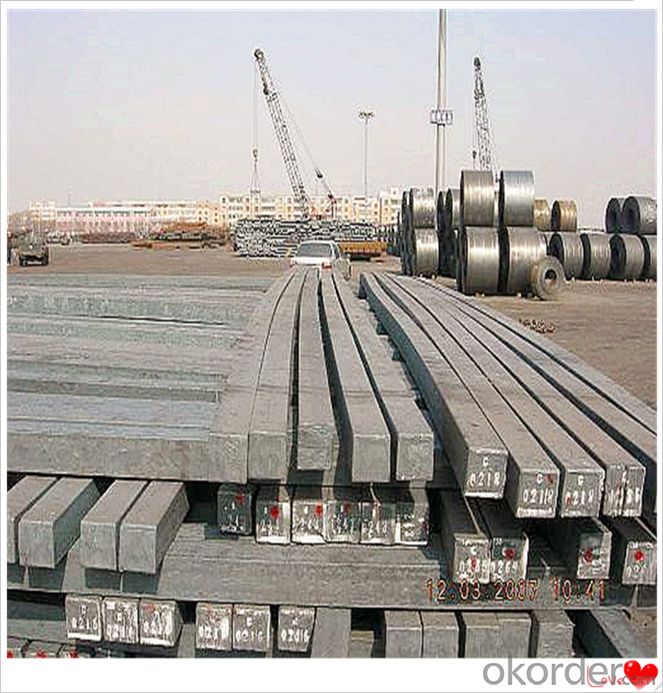
Processing
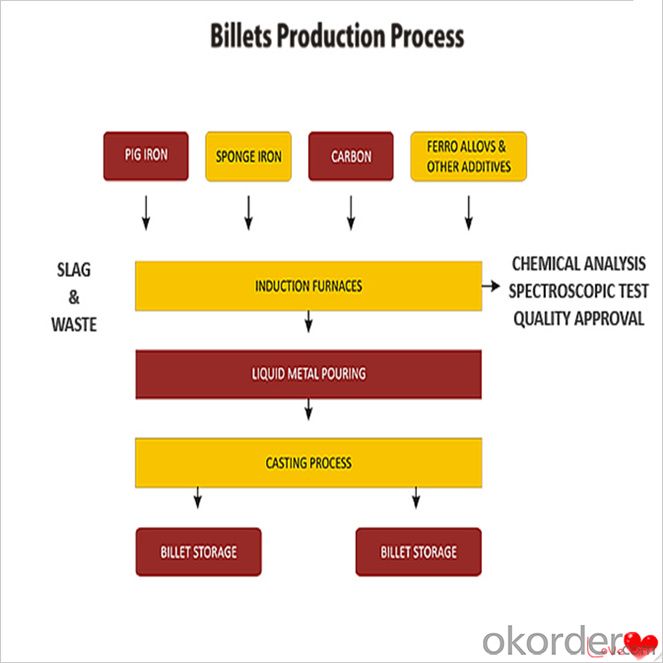
Usage-Billet Steel
Used for the plant, the bridge,shipment building high-rise building construction,lifting and transportation machinery, equipment manufracturing base building the support foundation pile manufacturing.
Billets, or ingots (as they sometimes referred to), are not of practical use until they have been formed into more functional shapes and sizes. While they have already been put in the furnace, they still require a series of shaping and molding procedures such as hot and cold working, milling and cutting before they are sold in hardware stores, or used for different applications. The unformed billets, however, can be used in striking currency such as coins and as reserves, similar to gold bars.
FAQ-Billet Steel
We have organized several common questions for our clients,may help you sincerely:
1) How about your company?
A world class manufacturer & supplier of castings forging in carbon steel and alloy steel,is one of the large-scale professional investment casting production bases in China,consisting of both casting foundry forging and machining factory. Annually more than 8000 tons Precision casting and forging parts are exported to markets in Europe,America and Japan. OEM casting and forging service available according to customer’s requirements.
2) How to guarantee the quality of the products?
We have established the international advanced quality management system,every link from raw material to final product we have strict quality test;We resolutely put an end to unqualified products flowing into the market. At the same time, we will provide necessary follow-up service assurance.
3) How long can we receive the product after purchase?
In the purchase of product within three working days, We will arrange the factory delivery as soon as possible. The pecific time of receiving is related to the state and position of customers.Commonly 7 to 10 working days can be served.
4)Do you have your own QC department?
Yes, we have, our QC department will inspect the goods during the process of mass production and after completion of production.
hot sale!!! Cast Steel Grades/ mild steel bar/ billet steel
(1): High quality steel with reasonable price.
(2): Wide excellent experiences with after-sale service.
(3): Every process will be checked by responsible QC which insures every product's quality.
(4): Professional packing teams which keep every packing safely.
(5): Trial order can be done in one week.
(6): Samples can be provided as your requirements.
- Q:What is the role of steel billets in the construction of underground tunnels?
- The construction of underground tunnels heavily relies on steel billets, which are cylindrical steel bars. These bars act as the primary raw material for manufacturing various structural components that are crucial in guaranteeing the stability and safety of the tunnel. One significant use of steel billets is in the production of rebar, also known as reinforcing bar. Rebars are inserted into the concrete walls and floors of the tunnel to provide tensile strength and prevent cracking or collapsing under the immense pressure exerted by the surrounding soil or water. These steel bars reinforce the concrete, making it more durable and resistant to deformation, ultimately enhancing the overall structural integrity of the tunnel. Moreover, steel billets are also utilized to create other essential tunnel components, including tunnel segments and steel arches. Tunnel segments are precast concrete elements that form the lining of the tunnel, often incorporating steel reinforcement for added strength. On the other hand, steel arches are employed in constructing tunnel roofs to offer extra support and stability. Additionally, steel billets are employed in the fabrication of various tunnel reinforcement systems like rock bolts and ground anchors. These systems help secure loose or unstable rock formations, preventing them from collapsing and jeopardizing the stability of the tunnel. Steel billets are also used in manufacturing tunnel supports such as steel ribs and beams, which provide additional strength and rigidity to the tunnel structure. In conclusion, steel billets are critical in the construction of underground tunnels. By being transformed into rebar, tunnel segments, steel arches, and reinforcement systems, they play a vital role in ensuring the structural integrity, stability, and safety of tunnels, ultimately facilitating efficient and secure transportation networks underground.
- Q:How are steel billets used in the production of pump parts?
- Steel billets are an essential component in the production of pump parts. These billets, which are semi-finished metal forms, serve as the starting material for manufacturing various pump components. Firstly, steel billets are heated and then molded into the required shape using a range of techniques such as forging, casting, or extrusion. This process ensures that the billets are transformed into the desired pump part, such as impellers, casings, or shafts. Once the billets have been shaped, they undergo further machining processes, such as milling, drilling, and turning, to achieve the precise dimensions and specifications needed for pump parts. These machining operations ensure that the billets are transformed into functional components that can effectively perform their intended tasks within the pump system. Moreover, steel billets provide the necessary strength and durability required for pump parts to withstand the demanding conditions and pressures associated with pumping operations. The high tensile strength and resistance to corrosion of steel make it an ideal material choice for pump components, ensuring their longevity and reliability. In addition, steel billets can be further treated or coated to enhance their performance characteristics. For instance, they can undergo heat treatment processes such as annealing, quenching, or tempering to achieve specific mechanical properties, such as improved hardness or increased resistance to wear and tear. Coatings, such as galvanizing or electroplating, can also be applied to steel billets to enhance their corrosion resistance. Overall, steel billets play a crucial role in the production of pump parts by providing a versatile and robust starting material that can be shaped, machined, and treated to meet the specific requirements of different pump systems. By utilizing steel billets, pump manufacturers can produce high-quality pump parts that ensure efficient and reliable pumping operations across various industries.
- Q:What are the challenges faced in the distribution and supply chain of steel billets?
- There are several challenges faced in the distribution and supply chain of steel billets. Firstly, one major challenge is the transportation of steel billets. Steel billets are heavy and bulky, requiring specialized equipment and infrastructure for their transportation. This can lead to higher logistics costs and difficulties in finding suitable transport options, especially for international shipments. Secondly, the storage and inventory management of steel billets can be challenging. Steel billets require proper storage facilities to prevent corrosion and damage. Additionally, managing inventory levels and ensuring timely deliveries can be complex, as steel billets are often sourced from multiple suppliers and delivered to various locations. Thirdly, quality control is a significant challenge in the distribution and supply chain of steel billets. Ensuring consistent quality throughout the supply chain requires strict adherence to quality standards and effective quality control measures. This includes regular inspections, testing, and certification processes to guarantee the integrity and suitability of the steel billets. Another challenge is the fluctuating demand and market conditions. The steel industry is highly cyclical, with demand and prices subject to economic fluctuations and global market trends. This poses challenges in terms of forecasting demand, managing production capacity, and optimizing inventory levels to meet customer requirements while minimizing costs. Furthermore, global trade regulations and customs procedures can create challenges in the distribution and supply chain of steel billets. Compliance with various import and export regulations, including trade restrictions and tariffs, can impact the flow of steel billets across different countries, leading to delays and additional costs. Lastly, ensuring sustainable and responsible sourcing practices is becoming increasingly important in the steel industry. Meeting environmental and social standards, such as responsible sourcing of raw materials and reducing carbon emissions, can be challenging for steel billet manufacturers and distributors. This requires implementing sustainable practices throughout the supply chain, which may involve additional costs and complexities. In conclusion, the distribution and supply chain of steel billets face challenges related to transportation, storage, quality control, demand fluctuations, trade regulations, and sustainable sourcing. Overcoming these challenges requires effective planning, strong partnerships, and the implementation of efficient processes to ensure a smooth and reliable supply of steel billets to customers.
- Q:What are the different types of steel billet packaging materials?
- There are various types of steel billet packaging materials available in the market, each with its own unique characteristics and benefits. Some of the commonly used packaging materials for steel billets include: 1. Wooden Crates: Wooden crates are a popular choice for packaging steel billets due to their strength and durability. They provide excellent protection against external impacts and are suitable for long-distance transportation. 2. Steel Strapping: Steel strapping is a strong and secure packaging material that is often used to bundle steel billets together. It provides high tensile strength and resistance to breakage, ensuring that the billets remain intact during handling and transportation. 3. Plastic Wrapping: Plastic wrapping is a cost-effective and lightweight packaging option for steel billets. It offers protection against moisture and dust, preventing any potential damage to the billets. Plastic wrapping can be easily applied and removed, making it a convenient choice for packaging. 4. Steel Framing: Steel framing is a heavy-duty packaging material used for larger and heavier steel billets. It provides maximum protection and stability during transportation, minimizing the risk of any deformation or damage to the billets. 5. Cardboard Boxes: Cardboard boxes are commonly used for smaller steel billets. They are lightweight, easy to handle, and offer sufficient protection against minor impacts and scratches. Cardboard boxes can be customized in various sizes and shapes to accommodate different billet dimensions. 6. Stretch Film: Stretch film is a flexible packaging material that is commonly used to wrap steel billets. It offers excellent protection against moisture, dust, and scratches. Stretch film also provides some level of stability to the billets, preventing any movement during transportation. It is important to consider the specific requirements of the steel billets, such as size, weight, and transportation conditions, when choosing the appropriate packaging material.
- Q:What is the role of steel billets in the construction of stadiums and arenas?
- Steel billets play a crucial role in the construction of stadiums and arenas as they are the primary raw material used to manufacture structural steel components. These billets are heated and shaped into various forms, such as beams, columns, and trusses, which provide the necessary support and framework for the overall structure. The high strength and durability of steel make it an ideal material to withstand the heavy loads and forces experienced in these large-scale facilities. Additionally, steel billets can be easily fabricated and assembled on-site, ensuring efficient construction and enabling the creation of complex designs and architectural features.
- Q:How do steel billets contribute to the overall vibration resistance of a product?
- The overall vibration resistance of a product can be significantly enhanced through the use of steel billets. Steel, with its high-strength properties, is an ideal material for reducing vibrations and improving product stability. In the manufacturing process, steel billets are commonly used as a raw material and are further processed into various shapes and forms. Steel billets possess a dense and uniform structure that enables them to effectively absorb and dissipate vibration energy. When integrated into a product, steel billets provide additional mass, which assists in dampening vibrations by absorbing and distributing energy throughout the structure. This added mass acts as a stabilizing force, preventing excessive movement and reducing the amplitude of vibrations. Furthermore, steel billets demonstrate exceptional mechanical properties, including high tensile strength and stiffness, which contribute to a product's overall vibration resistance. These properties allow steel billets to withstand dynamic forces and resist deformation caused by vibrations, ensuring the product's structural integrity. In addition to their superior mechanical properties, steel billets can be designed with specific geometries and cross-sectional shapes to further enhance their vibration resistance. For instance, the use of round or square billets with smooth surfaces minimizes stress concentration points and lowers the risk of fatigue failure. By optimizing the design and dimensions of steel billets, manufacturers can tailor a product's vibration resistance to meet specific requirements. To summarize, steel billets play a critical role in enhancing a product's overall vibration resistance. Their high mass, dense structure, and excellent mechanical properties allow them to effectively absorb and dissipate vibration energy, stabilize the product, and improve its structural integrity. By incorporating steel billets into the manufacturing process, manufacturers can ensure that their products are more resistant to vibrations, leading to enhanced performance and longevity.
- Q:How do steel billets contribute to the transportation industry?
- Steel billets are a vital component in the transportation industry as they are used to manufacture various parts and components for vehicles. These billets are transformed into products like engine blocks, chassis frames, axles, and suspension systems, which provide strength, durability, and stability to vehicles. Additionally, steel billets are also used to produce railway tracks and infrastructure, ensuring safe and efficient transportation of goods and people. Overall, steel billets play a crucial role in enhancing the performance, safety, and reliability of transportation systems.
- Q:How are steel billets used in the production of shipbuilding components?
- Steel billets are essential in the production of shipbuilding components as they serve as the primary raw material. Shipbuilding components require a high level of strength, durability, and corrosion resistance, all of which can be achieved through the use of steel billets. Firstly, steel billets are heated and then passed through a series of rolling processes to produce various shapes and sizes of steel plates, beams, and bars. These components are crucial in the construction of the ship's hull, superstructure, and other structural components. For example, steel plates are used to form the ship's outer shell, while beams and bars are utilized to provide support and stability. Furthermore, steel billets can be forged or machined to create specialized shipbuilding components such as propeller shafts, rudder stocks, and engine mounts. These components play vital roles in the ship's propulsion system, steering mechanism, and overall functionality. Additionally, steel billets can be used to manufacture pipes and tubes that are crucial for the ship's plumbing, ventilation, and fuel systems. The use of steel billets in shipbuilding ensures the vessels are built to withstand the harsh marine environment, including extreme weather conditions and corrosive seawater. Steel is known for its high strength-to-weight ratio, making it an ideal choice for constructing large and sturdy ships. Moreover, steel is easily weldable, allowing for efficient assembly and fabrication processes during ship construction. Overall, steel billets are a fundamental component in shipbuilding, providing the necessary strength, durability, and corrosion resistance required for the construction of various ship components. From the hull and superstructure to specialized parts, steel billets are indispensable in the production of shipbuilding components.
- Q:What is the average cost of transporting steel billets?
- The average cost of transporting steel billets can vary based on several factors, including the distance of transportation, the mode of transportation, the quantity of steel billets being transported, and the current market conditions. Typically, the cost of transporting steel billets ranges from $50 to $150 per metric ton. This cost covers expenses related to loading and unloading the billets, transportation fees, insurance, and any additional charges such as customs fees or tolls. It is important to consider that transportation costs differ significantly depending on the mode of transportation. For instance, road transport for steel billets tends to be more expensive due to higher fuel costs and limited capacity compared to rail or sea transport. Additionally, longer distances or remote locations may result in higher transportation costs due to increased logistics and infrastructure requirements. Market conditions and fluctuations in fuel prices also have an impact on the average cost. During periods of high demand or economic volatility, transportation costs may increase due to factors like heightened competition, fuel surcharges, or additional security measures. To obtain an accurate estimate for the average cost of transporting steel billets, it is advisable to seek quotes from multiple transportation providers or consult industry-specific sources for updated pricing information.
- Q:How do steel billets contribute to the construction industry?
- Steel billets are a crucial component in the construction industry for several reasons. Firstly, they serve as the raw material for the production of various steel products used in construction, such as beams, columns, and reinforcement bars. These products provide structural support and integrity to buildings and infrastructure projects. Steel billets are also essential for the manufacturing of precast concrete elements, which are widely used in construction. Pre-stressed concrete beams, for example, are reinforced with steel billets to enhance their strength and durability. This allows for the construction of larger and more complex structures, such as bridges, stadiums, and high-rise buildings. Moreover, steel billets play a vital role in the fabrication of steel pipes and tubes, which are extensively used in the construction of water supply systems, sewage lines, and gas pipelines. These pipes offer a reliable and efficient means of transporting fluids and gases, ensuring the proper functioning of various infrastructure networks. In addition to their structural applications, steel billets also contribute to the construction industry through their recyclability. Steel is one of the most recycled materials globally, and steel billets can be melted down and reused multiple times without any loss in quality. This not only reduces the demand for virgin steel production but also minimizes environmental impact and waste generation. Overall, steel billets are indispensable in the construction industry due to their versatility, strength, and recyclability. They serve as the backbone for the production of various steel products and play a crucial role in the construction of durable and sustainable buildings and infrastructure projects.
1. Manufacturer Overview |
|
|---|---|
| Location | |
| Year Established | |
| Annual Output Value | |
| Main Markets | |
| Company Certifications | |
2. Manufacturer Certificates |
|
|---|---|
| a) Certification Name | |
| Range | |
| Reference | |
| Validity Period | |
3. Manufacturer Capability |
|
|---|---|
| a)Trade Capacity | |
| Nearest Port | |
| Export Percentage | |
| No.of Employees in Trade Department | |
| Language Spoken: | |
| b)Factory Information | |
| Factory Size: | |
| No. of Production Lines | |
| Contract Manufacturing | |
| Product Price Range | |
Send your message to us
5p/Ps Steel Billets Q235,Q255,Q275,Q345,3SP,5SP,20MnSi
- Loading Port:
- China main port
- Payment Terms:
- TT OR LC
- Min Order Qty:
- 20 m.t.
- Supply Capability:
- 200000 m.t./month
OKorder Service Pledge
OKorder Financial Service
Similar products
New products
Hot products
Related keywords
































